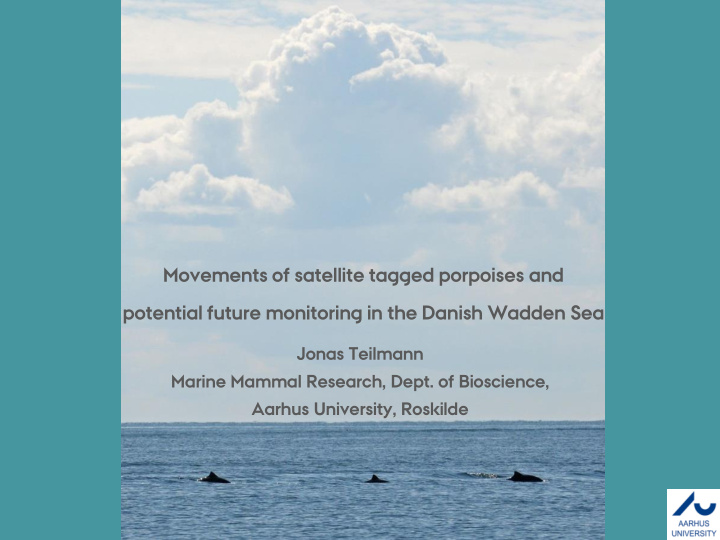



INSTITUT FOR BIOSCIENCE AARHUS UNIVERSITET Movements of satellite tagged porpoises and potential future monitoring in the Danish Wadden Sea Jonas Teilmann Marine Mammal Research, Dept. of Bioscience, Aarhus University, Roskilde
Tagging program in cooperation with Danish INSTITUT FOR BIOSCIENCE AARHUS UNIVERSITET pound net fishermen since 1997 - Approximately 200 porpoises e.g. Sveegaard et al. 2011 Marine Mammal Science
Long-term and large scale movements of porpoises from Greenland and North Sea Nielsen et al. 2018, Marine Ecology Progress Series
8 tagged porpoises visiting the Wadden Sea Porpoise Argos ID Tagging site Date Last location Duration Male 118 cm 138067 Rømø West 03-jun-14 04-okt-14 123 Danish Wadden Taged in the Male 127 cm 149165 Mandø/Knude Dyb 20-sep-16 04-jun-17 257 Male 140 cm 149166 Mandø/Knude Dyb 19-sep-16 26-apr-17 219 Sea Male 130 cm 149167 Mandø/Knude Dyb 19-sep-16 10-jun-17 264 Male 123 cm 149170 Mandø/Knude Dyb 19-sep-16 30-dec-16 102 Male 125 cm 149171 Mandø/Knude Dyb 21-sep-16 18-mar-17 178 Average 191 ed in Male 126 cm 83306 Fjellerup Strand 04-jul-11 09-nov-12 494 Tagg IDW Male 107 cm 138073 Fænø 30-okt-14 18-apr-15 170 Average 332
Movement of 8 satellite tagged porpoises using the Wadden Sea
Fine scale movements and dive depths for the first 10 days of 6 tagged porpoises
Part I - conclusions on Wadden Sea porpoise movements 1. First insight to porpoise movements in the Wadden Sea. 2. Porpoises tagged in the Wadden Sea are local to the area year round (only males tagged!). 3. Some movements between Denmark and Germany. 4. Porpoises visiting the Wadden Sea in winter and spring (from Inner Danish Waters) has a daily movement rate 2.5-8 times higher than Wadden Sea animals. 5. Limited dive data suggest bottom feeding in shallow waters (4-15 m) for the Wadden Sea porpoises. 6. Can we talk about Wadden Sea porpoises (population)?
Sampling super high resolution data for hours or low resolution up to years depending on question asked
Foraging Catching a fish blindfolded in a captive controlled experiment in Fjord&Belt
Animatrion of a feeding dive where a porpoise is catching 20 small fish Wisniewska et al. 2016. Current Biology
P orpoises dive to variable depths…
…and forage nearly continuously Benthic Pelagic foraging foraging Surface foraging
Consistent high foraging rate over 40 hrs – mostly at night Wisniewska et al. 2018, Marine Mammal Science
Prey size and daily consumption based on echograms from the DTAG recordings on porpoises Given a mean buzz rate for juveniles of 125/h and 1) assuming that the mean weight of fish eaten was around 1 g (5 cm goby or sand ell, see panel C on figure) and 2) a 90% prey capture success rate, 3) a porpoise would consume about 2.7 kg/24 h, which is roughly 10% of the body weight of a young porpoise, which fits well with other studies. Wisniewska et al. 2016, Current Biology
Social interactions Sørensen et al. 2018, Scientific Reports
Ship avoidance from wild porpoise Wisniewska et al. 2018, Royal Proceeding B
Reactions to fast ferries Wisniewska et al. 2018, Royal Proc. B
Porpoises can hear ship noise 16-73% of their time Wisniewska et al. 2018, Royal Proceeding B hp12_293a hp13_102a hp13_145a hp13_170a hp14_226b vessel noise exposure time (h) 11.5 17.4 2.1 2.4 3.4 vessel noise exposure time (%) 65 73 30 16 17 AIS data from 2010 http://www.soefartsstyrelsen.dk/ais/Sejladsmoenstre/Sider/WebMapServices.aspx
Porpoise avoidance to 1 min airgun exposure van Beest et al. 2018. Royal Society Open Science
Potential future monitoring in the Danish Wadden Sea Aerial surveys – little information gained from NOVANA (Danish Marine • Monitoring Program) Acoustic monitoring – could be used at the entrances of major tidal trenches • to monitor presence and movements. • Tagging more porpoises (females!) to understand better how they use the Wadden Sea. • Genetic comparison between Wadden Sea and North Sea porpoises. More studies on effects of disturbances will help manage populations. •
Thanks to co-authors, the amazing field team and the pound net fishermen The various projects were funded by the Danish Ministry of Environment, German Federal Agency for Nature Conservation (BfN), the Danish National Research Foundation, the Carlsberg Foundation, the Marine Alliance for Science and Technology Scotland (MASTS), Marie Curie-Sklodowska Award, DEPONS (Vattenfall, Forewind, ENECO Luchterduinen, DONG Energy and ScottishPower Renewables) and the Greenland Home Rule
Recommend
More recommend